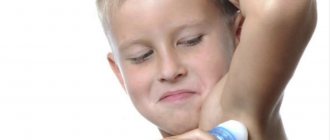Why does a child throw his head back?
The reasons may vary. Some of them require consultation with a doctor, others do not pose a danger to children and do not require medical intervention.
If a baby throws his head back in his sleep, there is no need to worry: up to 4 months this is not a deviation or a developmental anomaly. You should be wary only in situations where other unpleasant symptoms are noted. Children under one year old adapt to changed conditions, adapt to the world around them; a newborn often throws his head back out of comfort.
The problem may arise due to birth injuries in which the neck or back was damaged in the upper part. Damage occurs especially often if the baby was born by caesarean section and special forceps were used to remove it.
Neurological pathologies are also possible. A child may arch in cases where he has increased muscle tone, intracranial pressure, or lacks oxygen.
Safe reasons may be observed. If one of the parents likes to sleep in a similar position, the child copies the position.
Sometimes a child sleeps with his head thrown back due to tantrums. If the child is not sleeping, he can take a similar position when trying to roll over: this is how the baby helps himself to make the movement.
When you don't have to worry
As we can see, for physiological reasons, when a newborn arches his back and at the same time throws his head back, there is no need for parents to worry. Doctors consider this phenomenon to be quite normal for infants.
Let's consider the main physiological reasons for this phenomenon:
- Habit - while the baby was growing in his mother’s tummy, he could not always be in a comfortable position, so after being born, he takes a wide variety of poses and in this way tries to study his body (the first three to four months after birth).
- Increased muscle tone of the body - moderate muscle tone of a newborn baby is considered normal, so he tries to remove its excess on his own, tossing and turning and coming up with new poses with his head thrown back, his back arched, his legs intertwined, etc.
- Manifestation of feelings and emotions - since the baby cannot yet show his emotions and feelings (for example, fear, dissatisfaction, pain, etc.), during a hysteria he throws his head back and at the same time arches his back.
The latter reason may be explained by the immature nervous system and its unstable state. Adults may even experience a similar phenomenon themselves, especially if there are mental disorders in the nervous system. So, in moments of very strong excitement, you can notice excessive tension in the muscles of the neck and shoulders - a person throws back his head, arches his shoulders and back.
Experts recommend: carefully shift the baby to give him a different position or change his position, for example, turn him over on his tummy. A nightly massage before bed will also help, as it will relieve increased muscle tone and the newborn will sleep better.
Adult Actions
It is necessary to contact a neurologist. The doctor should be informed about all observed symptoms, their severity, and frequency.
A special massage will help. It is not recommended to prescribe treatment measures or massage on your own: even a slight violation of technology can harm the baby. It's better to consult a specialist. Parents can massage their child’s fingers at home: this action is safe and can alleviate symptoms.
If your baby throws his head back in his sleep, you can try infant swimming. Before doing this, you should consult your doctor. Swimming will help relax your muscles and reduce tone. At home, it is recommended to add medicinal herbs to the water. Plants that have a calming effect should be used: chamomile, motherwort.
You can perform special gymnastics. The set of exercises should be prepared by a doctor. This measure helps improve coordination. General and local blood circulation becomes better, joints are developed. The child's appetite improves. Falling asleep is easier, sleep is better quality.
Reasons to be wary
In addition to the above reasons that do not cause panic among parents, there are several more that are not so harmless, plus they require a visit to a pediatrician or neurologist.
Muscle hypertonicity
The concept itself, I think, doesn’t really need to be deciphered. It means that the muscles are in increased tone. In addition to the fact that this causes some inconvenience to the child, plus, if this disease is neglected, it can lead to serious pathologies.
This disease is determined after 4 months. If a child begins to arch his back within a month, then this is not a big deal. In addition to hypertonicity, he might simply want to change his position.
Determining hypertension in a child over 4 months old is quite simple:
When your baby is lying on his back, try placing your hand under his head and lifting his head up so that his chin touches his chest. If you fail to do this, it means that the muscles are in strong tone.
Place the child on his stomach during the next “attack”. If, while lying on his stomach, he throws his head back strongly, plus his shoulder blades also slightly involuntarily twist, then this definitely means that your child has hypertonicity.
Increased intracranial pressure
In addition to the fact that the baby arches, he also spits up. After all, as you know, high blood pressure can make a person feel sick. The child does not calm down even if you start stroking his back or tummy.
If you observe this in your child, you should immediately consult a doctor. Pressure is no joke
The child throws his head back: the opinion of Dr. Komarovsky
In Komarovsky’s opinion, if the baby sleeps with his head thrown back, you should not take any measures until the age of three months, since all children throw their heads back during this period. In addition, you can easily cause harm when interfering. The only safe way is baths with medicinal herbs, which should be done daily before bedtime. Add decoctions of string and chamomile to the bathing water.
The whims of a newborn
If a child arches his back and is capricious without any serious reason, then parents need to try to wean the child from such hysterics and whims. This can best be done by switching his attention to something else or simply distracting him at the moment when he is capricious.
Manifestations of a baby’s whims can most often be observed during meals. When a child eats, his whims can be motivated by only two reasons:
- Normal pampering, when the child is already completely full, but does not want to tear himself away from the breast and thus begins to be capricious.
- Insufficient quantity of breast milk or its unsatisfactory taste. As for the taste of breast milk, this question completely depends on the mother, who should be more careful in selecting products for her table. If the mother produces an insufficient amount of milk and then this condition can also be accompanied by whims and arching of the back.
The baby may also arch his back and cry if he is about to master it. At the same time, nothing bothers him; he grunts, but does not cry. He can behave this way if he wants to reach out to some object that interests him or get a better look at it. In this case, the baby needs to be helped to acquire a position in which it will be as comfortable as possible for him to examine the object of interest.
If the baby arches his back, the first thing parents should do is seek help from a doctor. An experienced specialist will be able to promptly recognize a serious disease that needs to be treated. If there are no serious reasons for this condition, then he will prescribe a massage or a set of special exercises. All this will help keep the child healthy and will contribute to his development strong and healthy.
Parents often notice that the child throws his head back and begins to arch. Special attention should be paid to this behavior of the baby, as this may be a sign of some kind of developmental disorder of the nervous system.
When is it necessary to consult a neurologist?
A doctor's help will be required if the birth was difficult, since there is a high probability of injury, which may cause abnormalities to develop. The sooner the child is shown to the doctor, the sooner the diagnosis will be made and treatment prescribed; there will be fewer consequences, complications will not be as dangerous as if there is a delay. It is especially important to show the child to the doctor in a timely manner if, after childbirth, hematomas remain on the head, or if developmental disorders of the central nervous system organs are diagnosed.
It is necessary to show the baby to a specialist if there are signs of hypertonicity. If the child arches while lying on his side, there is decreased interest in food, low activity and frequent regurgitation, one limb moves worse than the other, it is also important to start treatment on time. In addition, a situation when a baby shakes its head from side to side in its sleep, or when the position of the head changes, a crying baby’s arms and legs begin to shake, is considered an alarming symptom.
You can consult a doctor for prevention if parents are not sure about the nature of the observed phenomenon. The doctor will tell you whether there is a pathology. If the doctor does not find any dangerous abnormalities, but the parents are still worried, you can visit another specialist and get a second opinion. This will help avoid medical errors and incompetence.
The baby arches his back: serious reasons
Often in infants there is a violation of the tone (hypertonicity) of the muscles of the back and neck ,
which becomes the reason for “standing on the bridge”.
If your baby has reached 3 months of age, you can check for yourself whether he has excessive muscle tension. To do this, you need to put the baby on his tummy and watch him. Increased tone of the muscles of the back and back of the neck is indicated by throwing the head back and involuntary raising of the shoulders. If the muscles are overstrained on one side, the baby will fall on his side.
In this case, you should consult a neurologist. Usually, for hypertonicity, drug treatment is not prescribed, but it is recommended to undergo a course of relaxing massage and perform special exercises. Parents can easily master basic massage techniques on their own, making them an additional way of contact with the baby. It is also useful to add soothing herbal infusions to the bath when bathing a baby to relieve tension.
The baby arches his back
often due to neurological disorders, including
increased intracranial pressure
. In this case, such behavior of the baby may signal the presence of some disease - from metabolic disorders to hydrocephalus and brain tumor. The newborn often cries loudly, arches his back restlessly, and cannot be calmed down by massage and stroking; regurgitation and even vomiting are possible.
To exclude the presence of pathology and start treatment on time, it is necessary to examine the baby by a doctor.
If the child is very small, under the age of 3-4 months, he may cry loudly for a long time and arch his back due to unpleasant or painful sensations
. For example, this may be due to intestinal colic or dysbiosis. Place a warm dry compress on the baby's tummy, stroke the tummy clockwise, give dill water to drink, and after the pain stops, the child will calm down.
If arching of the back is accompanied by difficulty breathing in a child, this indicates nasal congestion. Rinse your baby's nose with a weak saline solution or a special product.








